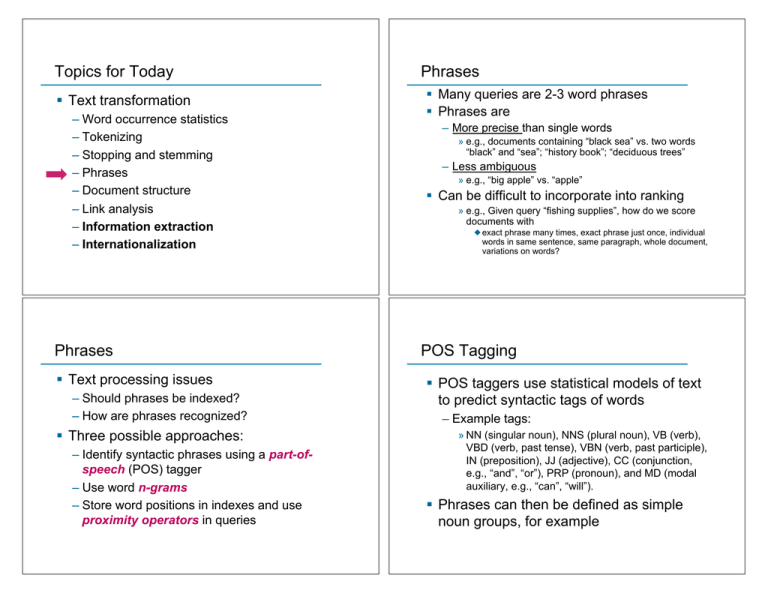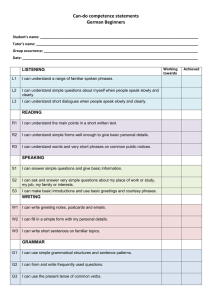
Topics for Today
! Text transformation
– Word occurrence statistics
– Tokenizing
– Stopping and stemming
– Phrases
– Document structure
– Link analysis
– Information extraction
– Internationalization
Phrases
! Text processing issues
– Should phrases be indexed?
– How are phrases recognized?
! Three possible approaches:
– Identify syntactic phrases using a part-ofspeech (POS) tagger
– Use word n-grams
– Store word positions in indexes and use
proximity operators in queries
Phrases
! Many queries are 2-3 word phrases
! Phrases are
– More precise than single words
» e.g., documents containing “black sea” vs. two words
“black” and “sea”; “history book”; “deciduous trees”
– Less ambiguous
» e.g., “big apple” vs. “apple”
! Can be difficult to incorporate into ranking
» e.g., Given query “fishing supplies”, how do we score
documents with
! exact phrase many times, exact phrase just once, individual
words in same sentence, same paragraph, whole document,
variations on words?
POS Tagging
! POS taggers use statistical models of text
to predict syntactic tags of words
– Example tags:
» NN (singular noun), NNS (plural noun), VB (verb),
VBD (verb, past tense), VBN (verb, past participle),
IN (preposition), JJ (adjective), CC (conjunction,
e.g., “and”, “or”), PRP (pronoun), and MD (modal
auxiliary, e.g., “can”, “will”).
! Phrases can then be defined as simple
noun groups, for example
POS Tagging Example
Example Noun Phrases
(a very old POS tagger)
Word N-Grams
! POS tagging too slow for large collections
! Simpler definition – phrase is any sequence
of n words – known as n-grams
– bigram: 2-word sequence, trigram: 3-word
sequence, unigram: single words
– N-grams also used at character level for
applications such as OCR
! N-grams typically formed from overlapping
sequences of words
– i.e. move n-word “window” one word at a time in
document
N-Grams
! Frequent n-grams are more likely to be
meaningful phrases
! N-grams form a Zipf distribution
– Better fit a Zipf distribution than words alone
! Could index all n-grams up to specified
length
– Much faster than POS tagging
– Uses a lot of storage
» e.g., document containing 1,000 words would contain
3,990 instances of word n-grams of length 2 ! n ! 5
Google N-Grams
Google books n-gram corpus
! Web search engines index n-grams
! Google n-gram sample:
! Most frequent trigram in English is “all rights
reserved”
– In Chinese, “limited liability corporation”
Topics for Today
! Text transformation
– Word occurrence statistics
– Tokenizing
– Stopping and stemming
– Phrases
– Document structure
– Link analysis
– Information extraction
– Internationalization
Information Extraction
! Automatically extract structure from text
– annotate document using tags to identify
extracted structure
! Named entity recognition
– identify phrases that refer to something of
interest in a particular application
– e.g., people, companies, locations, dates,
product names, prices, etc.
Named Entity Recognition
Named Entity Recognition
! Rule-based
– Uses lexicons (lists of words and phrases) that
categorize names
» e.g., locations, peoples’ names, organizations, etc.
– Rules also used to verify or find new entity names
! Example showing semantic annotation of
text using XML tags
! Information extraction also includes
document structure and more complex
features such as relationships and events
» e.g., “<number> <word> street” for addresses
» “<street address>, <city>” or “in <city>” to verify city
names
» “<street address>, <city>, <state>” to find new cities
» “<title> <name>” to find new names
Named Entity Recognition
HMM for Extraction
! Rules either developed manually by trial
and error or using machine learning
techniques
! Statistical
! Resolve ambiguity in a word using context
– use a probabilistic model of the words in and
around an entity
– probabilities estimated using training data
(manually annotated text)
– Hidden Markov Model (HMM) is one approach
Covered in CS4740 NLP
– e.g., “marathon” is a location or a sporting
event, “boston marathon” is a specific sporting
event
! Model context using a generative model of
the sequence of words
– Markov property: the next word in a sequence
depends only on a small number of the
previous words
Learn a HMM from training data
HMM for Extraction
! To recognize named entities, find
sequence of “labels” that give highest
probability for the sentence
• Each state is associated with a probability
distribution over words (the output)
– only the outputs (words) are visible or
observed
– states are “hidden”
– e.g., <start><name><not-anentity><location><not-an-entity><end>
! Viterbi algorithm used for recognition
Named Entity Recognition
NE recognition
! Accurate recognition requires about 1M
words of training data (1,500 news stories)
! Not generally found to be helpful during
search
! Useful for domain-specific or vertical search
engines
! Useful for displaying results, browsing
! Critical for question answering applications
– may be more expensive than developing rules
for some applications
! Both rule-based and statistical can achieve
about 90% effectiveness for categories
such as names, locations, organizations
– others, such as product name, can be much
worse
Internationalization
! 2/3 of the Web is in English
! About 50% of Web users do not use
English as their primary language
! Many (maybe most) search applications
have to deal with multiple languages
– monolingual search: search in one language,
but with many possible languages
– cross-language search: search in multiple
languages at the same time
Chinese “Tokenizing”
Internationalization
! Many aspects of search engines are
language-neutral
! Major differences:
– Text encoding (converting to Unicode)
– Tokenizing (many languages have no word
separators)
– Stemming
! Cultural differences may also impact
interface design and features provided


